|
Last time I showed you some beautiful flowers from our garden, but as spring has come and sun is shining more often again, also many little animals are getting more active and visible. In this article I focused mainly (but not solely) on insects. As some of the creatures are really small, the camera of my good, old mobile phone ("Huawei Mate 8") was partly stretched to it's limits. Nevertheless I decided to show you also some photos which are not perfect concerning clearness and richness of detail, just to convey you an impression of the full diversity of life in our garden. |
Im letzten Artikel zeigte ich euch einige schöne Blüten in unserem Garten, aber einhergehend mit dem seit Frühlingsbeginn häufigeren Sonnenschein, werden nun auch viele Kleintiere immer aktiver und sichtbarer. Diesmal fokussierte ich mich in erster Linie (aber nicht ausschließlich) auf Insekten. Aufgrund der geringen Größe einiger Kreaturen stieß die Kamera meines guten, alten Handys ("Huawei Mate 8") teilweise an ihre Grenzen. Nichtsdestotrotz entschied ich mich dazu, auch einige weniger scharfe und detailreiche Fotos in den Artikel aufzunehmen, um ein Bild von der ganzen Vielfalt des Lebens in unserem Garten zu vermitteln. |
Hymenoptera / Hautflügler
| A 'western honey bee' (Apis mellifera) close up. | Eine 'Westliche Honigbiene' (Apis mellifera) in Großaufnahme. |
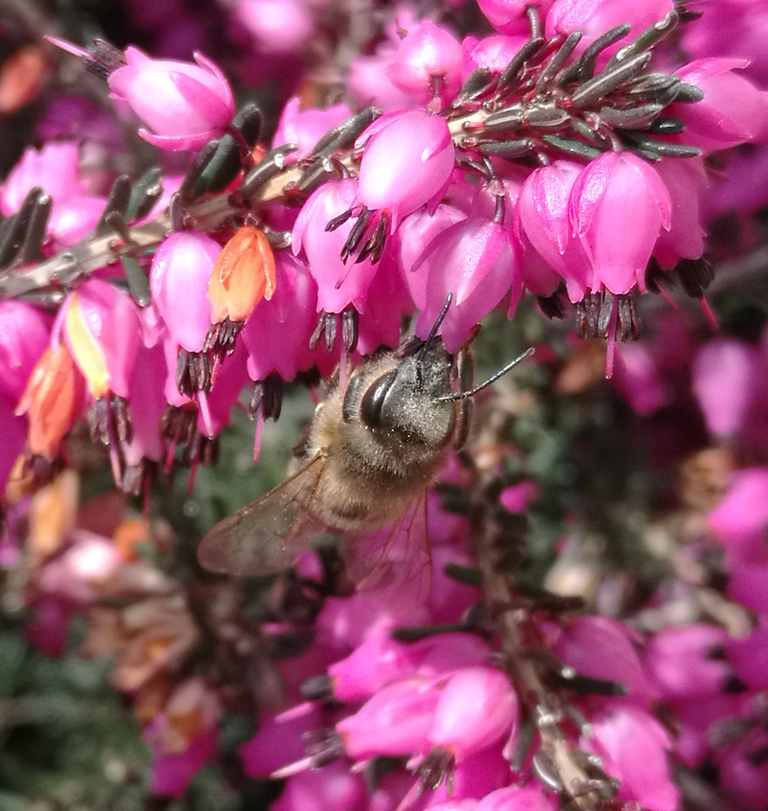

| 'Hornfaced bee' (Osmia cornuta) landing at a plant of the genus Muscari. | 'Gehörnte Mauerbiene' (Osmia cornuta) beim Anflug auf eine 'Traubenhyazinthe' (Gattung Muscari). |
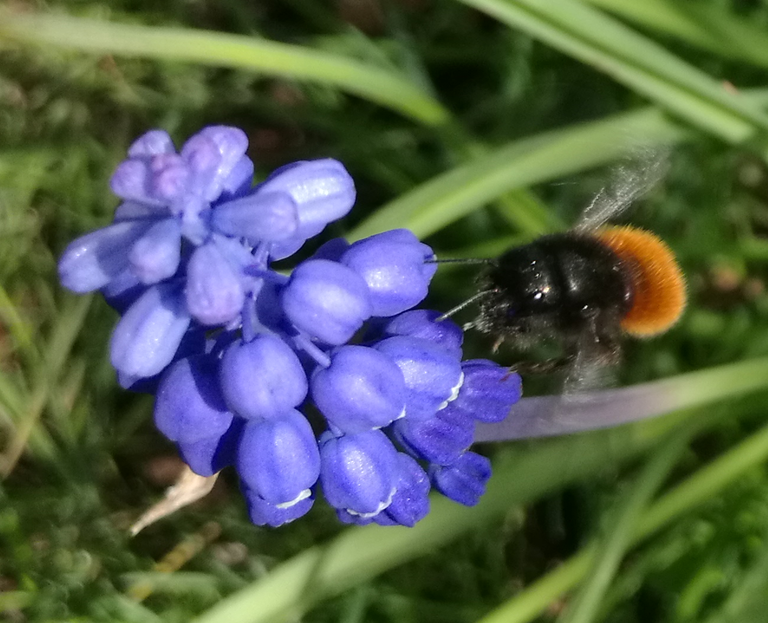
| 'Large earth bumblebee' (Bombus terrestris). | 'Dunkle Erdhummel' (Bombus terrestris). |

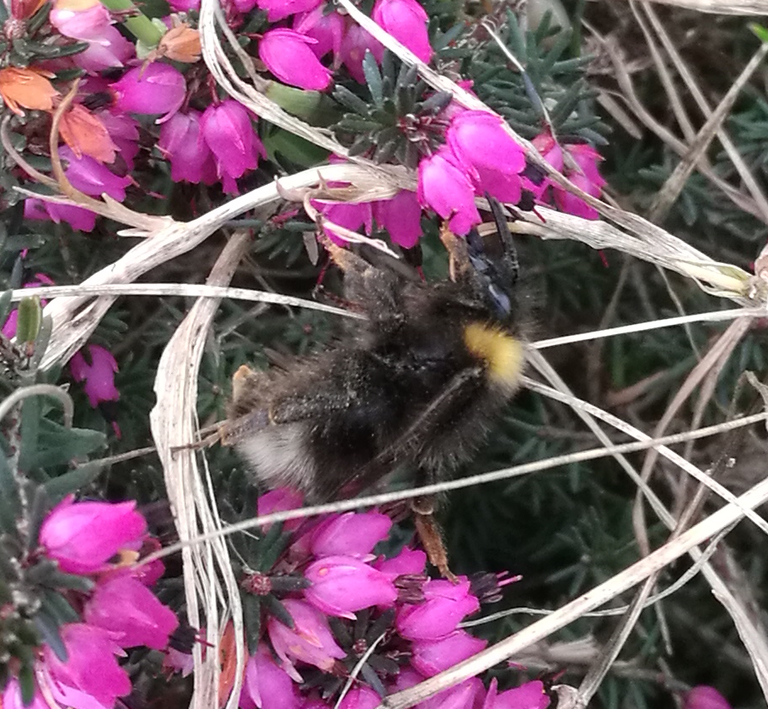
| 'Red-tailed bumblebee' (Bombus lapidarius) on 'dandelion' (Taraxacum officinale). | 'Steinhummel' (Bombus lapidarius) auf Löwenzahnblüte (Taraxacum officinale). |
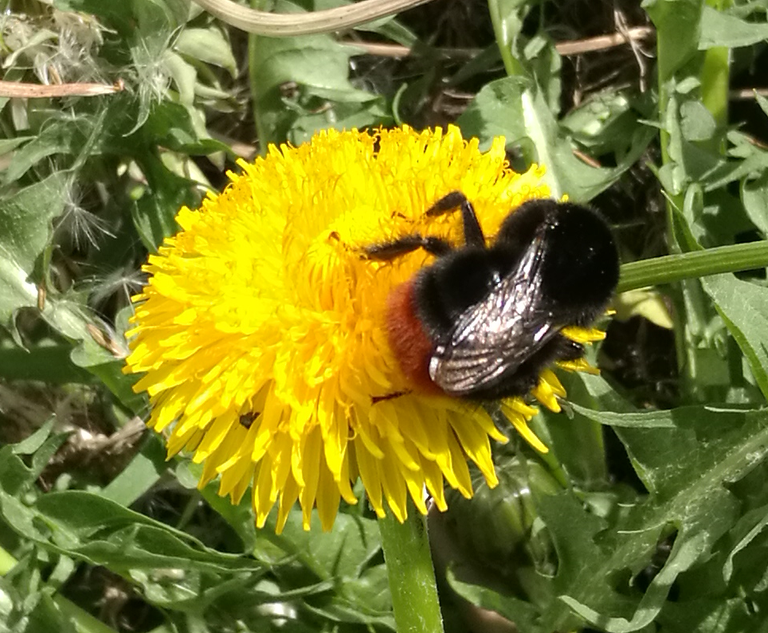

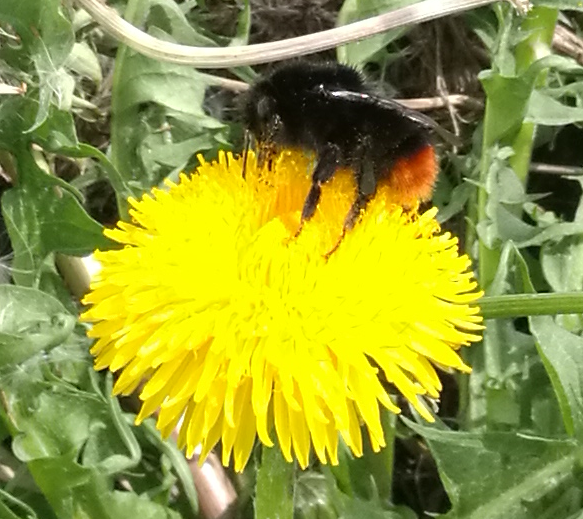
Heteroptera / Wanzen
| 'Mottled Shieldbug' (Rhaphigaster nebulosa). | 'Graue Gartenwanze' (Rhaphigaster nebulosa). |
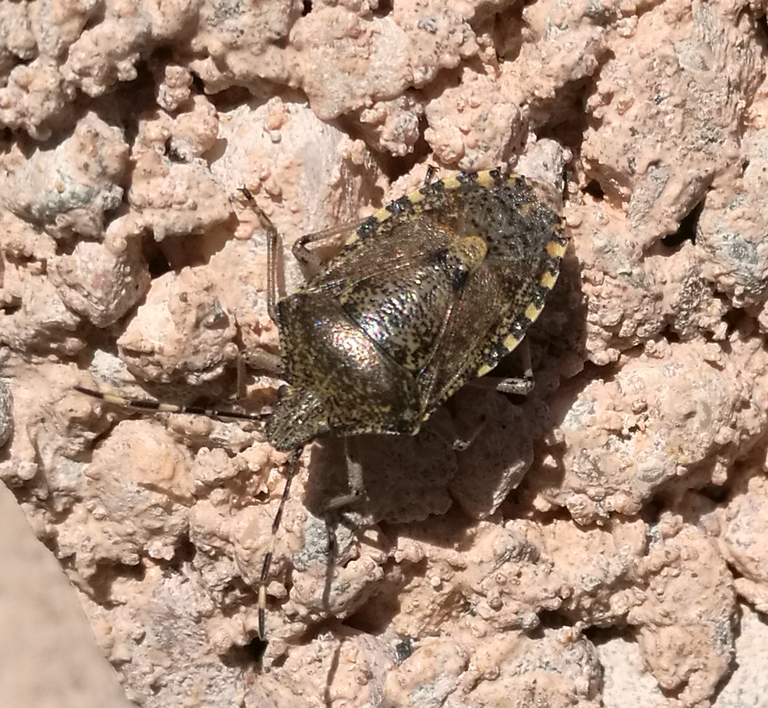
| Most of the time birds avoid to eat 'firebugs' (Pyrrhocoris apterus) because of their red poisonousness signalizing warning colors. However, here there is a case of Batesian mimicry: the bug is harmless but because of its color predators confuse it with venomous related species which it is imitating, but at the same saves the energy expenditure to produce effective poison. | Die 'Gemeine Feuerwanze' (Pyrrhocoris apterus) wird von Vögeln meist verschmäht, da ihre rote Warnfarbe Giftigkeit signalisiert. Tatsächlich handelt es sich jedoch um einen Fall Bates’scher Mimikry: Die Wanze ist ungefährlich, wird aber ihrer Farbe wegen mit giftigeren verwandten Arten verwechselt, welche sie imitiert, sich aber zugleich die energieaufwändige Produktion wirksamen Gifts erspart. |
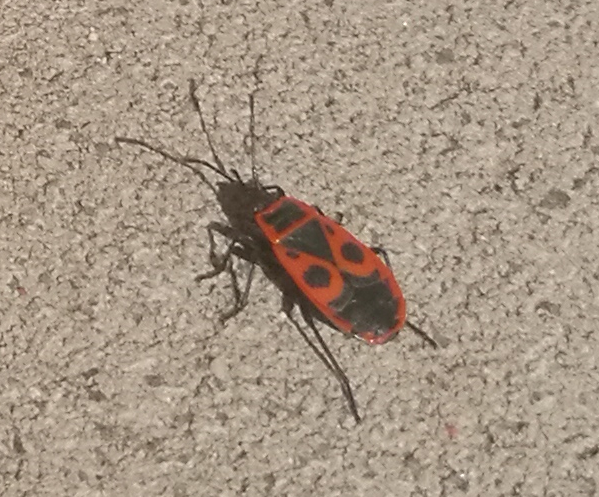
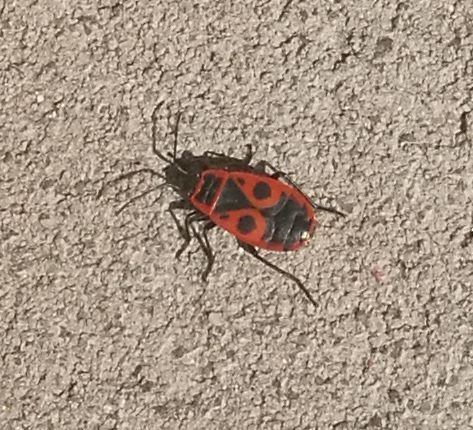
| What will have been the result of the encounter of these two bug species ...? | Wie die Begegnung dieser beiden Wanzenarten wohl geendet haben wird ...? |
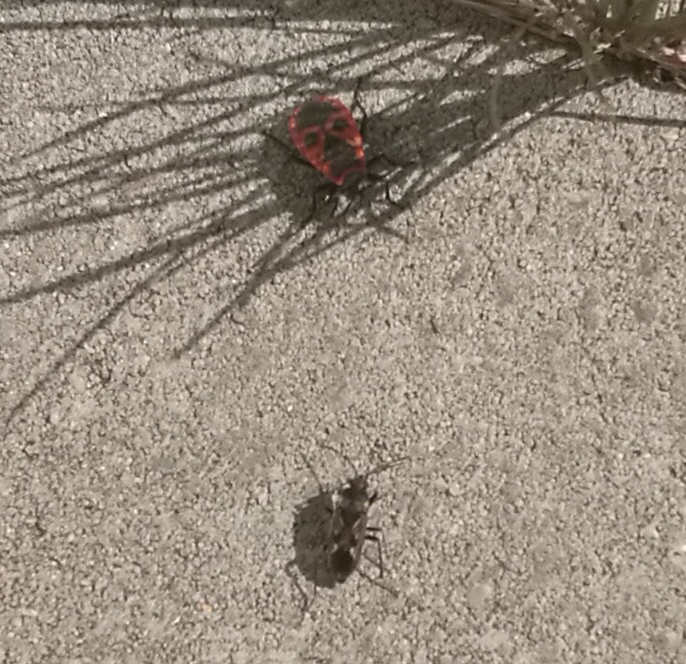
Lepidoptera / Schmetterlinge
| A colorful 'small tortoiseshell' (Aglais urticae). | Ein farbenfroher 'Kleiner Fuchs' (Aglais urticae). |
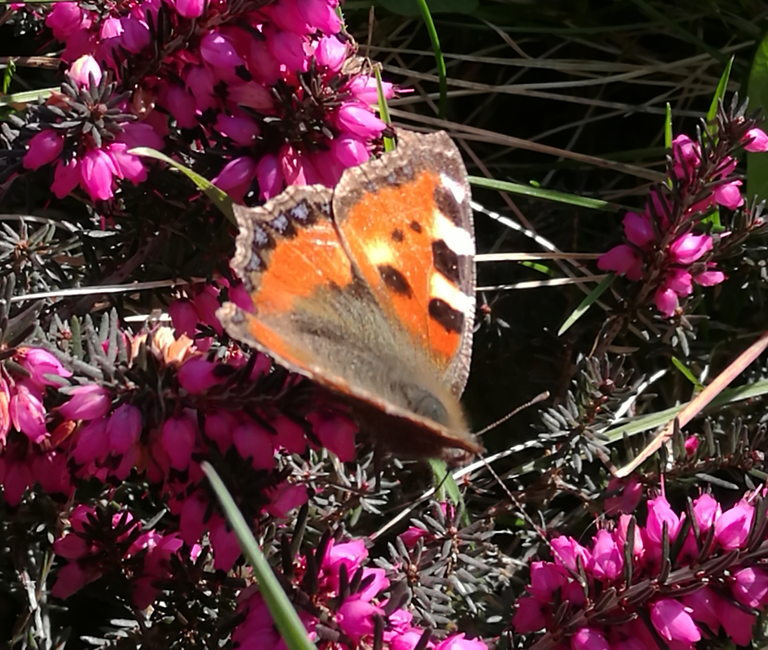
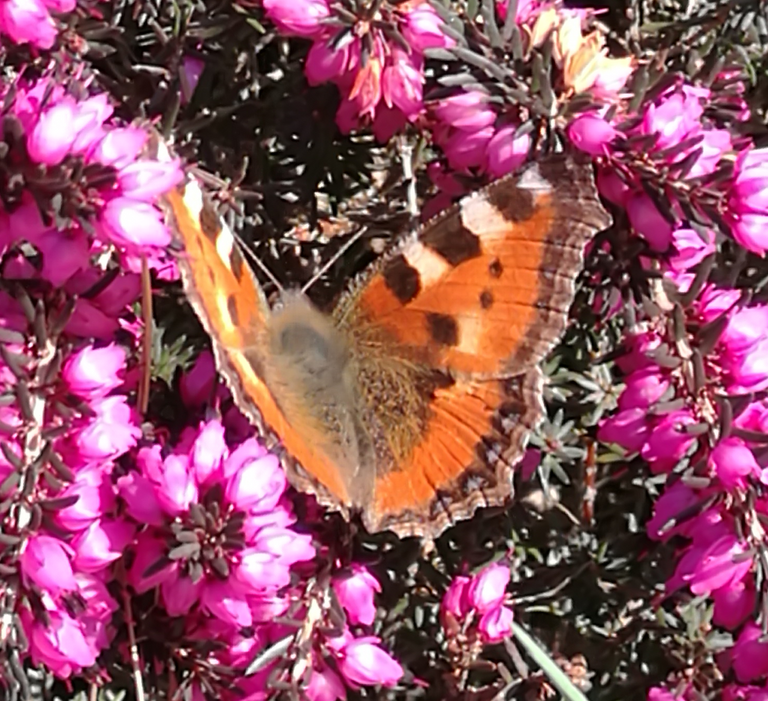
| In my opinion the 'peacock butterfly' (Aglais io) is one of the most beautiful butterflies one can find in Germany. | Das 'Tagpfauenauge' (Aglais io) ist meiner Meinung nach einer der schönsten Schmetterlinge Deutschlands. |

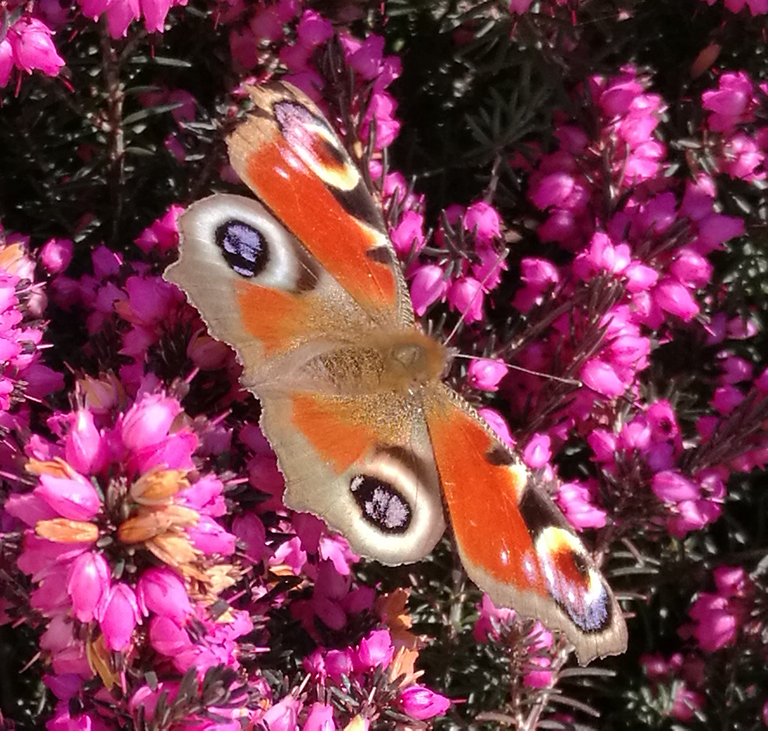
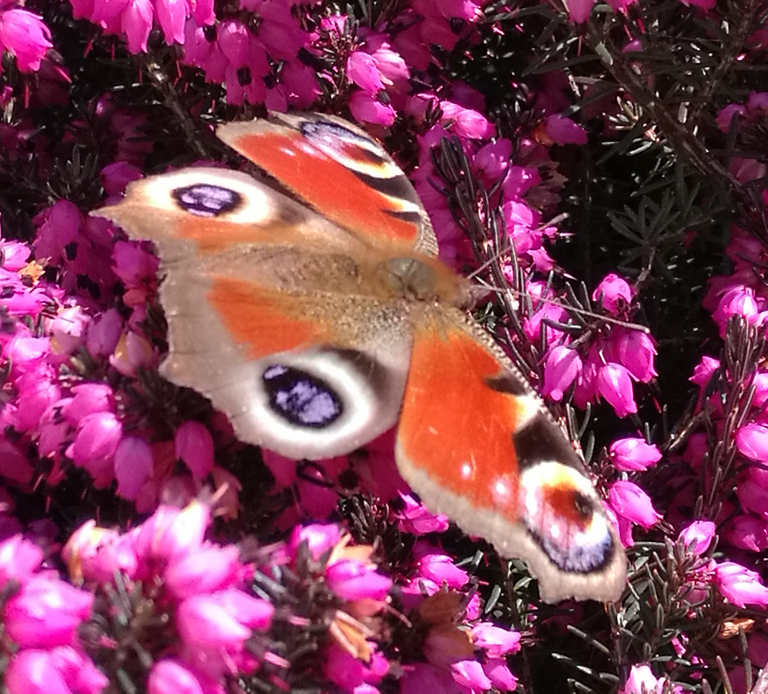
| Here you can see both butterflies together on the same plant (genus Erica), which is a real 'insect magnet'. | Hier sind beide Schmetterlinge gemeinsam auf derselben Heidekrautpflanze (Gattung Erica) - ein wahrer 'Insektenmagnet' - zu sehen. |
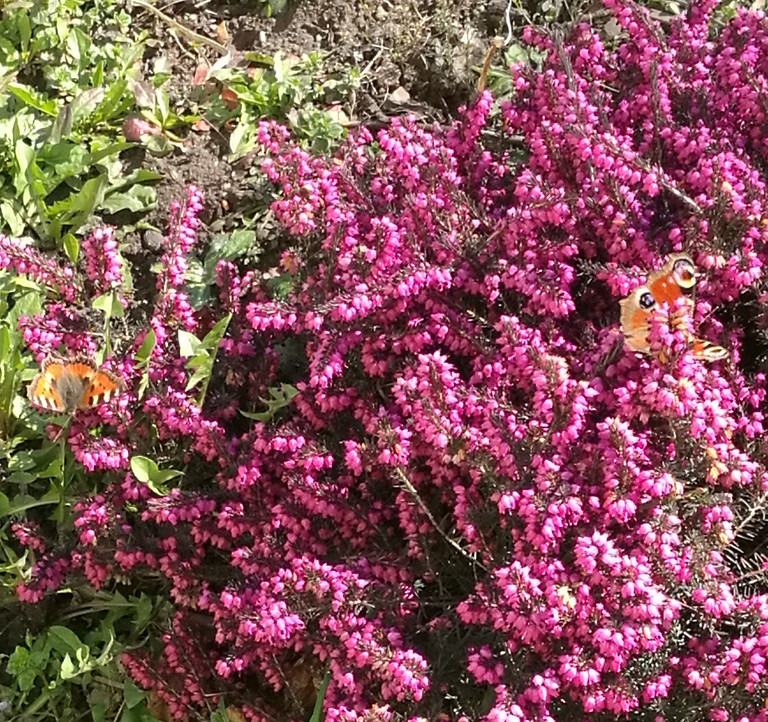
The following pictures were made at night with flashlight. |
Die folgenden Bilder nahm ich nachts mit Blitzlicht auf. |
| 'Common earwig' (Forficula auricularia). The bigger and also bent forceps (cerci) at the end of the abdomen show that we see a male exemplar here. | 'Gemeiner Ohrwurm' (Forficula auricularia). An den großen, gebogenen Zangen (Cerci) des Abdomenendes lässt sich erkennen, dass es sich um ein männliches Exemplar handelt. |
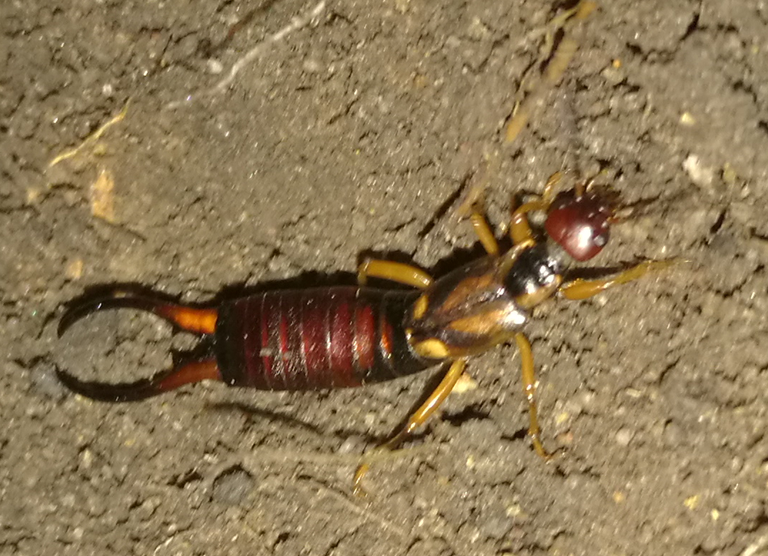
| A night active 'crab spider' (family Thomisidae ). | Eine nachtaktive 'Krabbenspinne' (Familie Thomisidae ). |

| A 'common woodlouse' (Oniscus asellus). | Eine 'Mauerassel' (Oniscus asellus). |
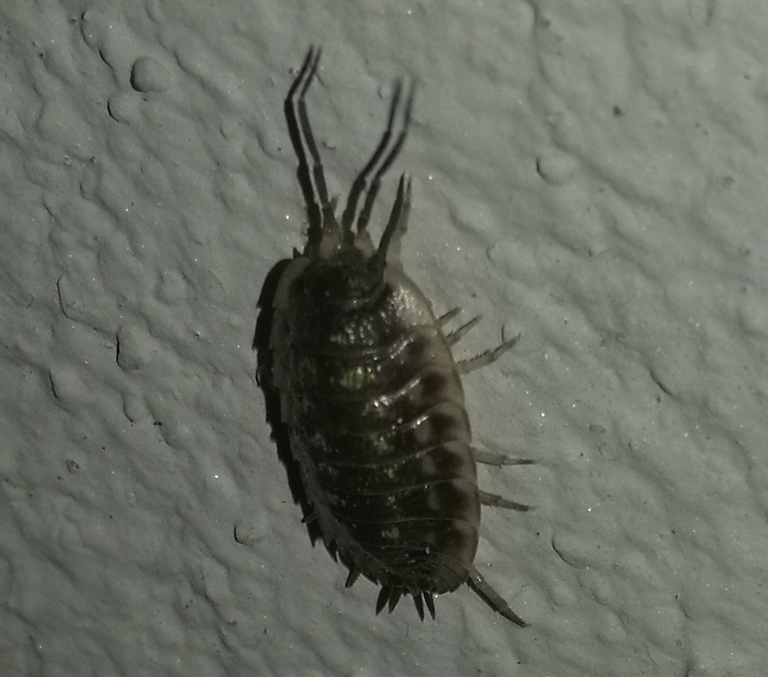
| Unfortunately 'leopard slugs' (Limax maximus) often get killed because gardeners believe them to be vermin even if they don't affect living plants opposite to the very quickly increasing "Spanish slug" (Arion vulgaris). Instead of that they feed on fungi (which don't belong to the plants!) and decaying organic substances. Besides they eat the eggs of other kind of slugs and sometimes they actually attack adult slugs. | Leider werden 'Tigerschnegel' (Limax maximus) oft für Gartenschädlinge gehalten und getötet, obwohl sie im Gegensatz zur sich sprunghaft verbreitenden "Spanischen Wegschnecke" (Arion vulgaris) keine lebenden Pflanzen befallen. Statdessen ernähren sie sich von Pilzen (die nicht zu den Pflanzen gehören!) und verwesenden organischen Substanzen. Außerdem fressen sie die Eier anderer Schneckenarten und greifen zuweilen sogar erwachsene Wegschnecken an. |

This is a wonderful time to take pictures of flowers and animals. Thanks for the precision in describing the small animals ..
Sehr schön Aufnahmen hast du da gemacht. Wenn man bedenkt dass diese mit einer Handykamera gemacht wurden echt top!
So ähnlich sieht es bei uns im Garten inzwischen auch aus.
Einfach herrlich wenn der Frühling den Winter verdrängt 😁
Beautiful pictures and I cannot believe that they have been taken with mobile phones.
Apart from beautiful flowers, there are also amazing small inhabitants in your garden. Ah! A lot of them with interesting information! It’s great that you know what kinds of their species very well. I admire you on this.
In the meantime, I especially love the “peacock butterfly” among the pink flowers, really beautiful! You took great photos of those inhabitants and flowers. Well done, as always! ;)
Hui, great pictures! I did not even know that there are so many different sub types and names. Impressive what you found in your garden.
Most of them are super important as well. Especially the bees
Many greetings
Jan
Actually my article shows only a few. For example there are living (estimated) more than 400000 beetle species (Coleopteraa) on earth.
Danke für diesen schön bebilderten, informativen und lehrreichen Beitrag!
Besonders gut gefällt mir, dass du uns auch Geschöpfe zeigst, die im Allgemeinen wenig Aufmerksamkeit genießen oder als "Schädlinge" ihr kurzes Dasein fristen.
Wunderschön sind die Schmetterlinge in Kombination mit dem Heidekraut - eine prächtige Farbkomposition!
Wow! Du kennst dich echt gut aus! Woher kommt das? Ist das ein Hobby von dir? Beruflich ist das nicht bedingt! Danke für den sehr informativen Artikel! Man muss mit offenen Augen durch seine Umgebung gehen. Dann entdeckt man auch die kleinen Schönheiten!
Mein Interesse an Insekten reicht in meine Kindheit zurück: Mein Vater ist ebenfalls Naturliebhaber und auch Imker. Ich habe dann später Biologie studiert und mich in meiner Diplomarbeit mit der Entomofauna des damals noch existierenden botanischen Gartens der Universität des S(p)aarlandes beschäftigt. :)
Aaahh! Also doch auch gewissermaßen beruflich bedingt ... Ich kenne ja auch alle diese Insekten vom Ansehen (ausser die lustige Spinne), aber könnte nicht alle Namen benennen - geschweige denn die lateinischen! Tol
Ein sehr sehr schöner Artikel, über den nicht zu diskutieren ist!
Ich bin voller Respekt bezüglich deiner Kenntnisse der Fauna und Flora!
Herzlichen Dank!
Sehr beeindruckend mein Lieber! Durch dich werden wir alle noch zu Insektenexperten :-)
Bei euch im Garten ist echt was los!
Erst gestern habe ich gehört, wie eine Mutter ihrem Kind über den "Feuerkäfer" erzählt hat, sie sind echt faszinierend!
Ich hab deinen Post durch Zufall gefunden, weil ich den Tag Deutsch angeklickt habe. Sowohl deine Bilder als auch der Text super klasse. Mir sind diese kleinen Buddies auch aus dem Garten meiner Mutter wohl bekannt. ;-) Danke, dass du dir so viel Mühe gemacht hast, all die tollen Schnappschüsse zu machen und mit uns zu teilen. :-)
Das hört man gern! :)
Di weist gar nicht, wie oft ich die Feuerwanze in den Jahren als Landschaftsgärtner gesehen habe. Fast täglich. Ein sehr schöner Bericht von dir lieber @jaki01 für deinen Garten und den Pflanzen und Tieren darin.
I'm astounded by the variety of species that can be found in your garden and what's more amazing is your knowledge about the species (names, characteristics, and importance to nature), that's valuable.
Your post is entertaining and actually engaging, by the way you did a great job in the photos even with the use of smartphone. The substance of your post and your blogging style are the things that set you appart from the rest.
I'm a nature lover and I really enjoyed reading this article, please keep it up. I'm already looking forward to your next blog :)
Lastly, that "crab spider", gave me the chills :D
Mit Beobachtungen von Lebewesen aller Art könnt ich den ganzen Tag zubringen und es freut mich zu sehen, das eine Biene, nicht bei jedem gleich eine Biene ist :)!
Schätze die 2 Wanzen sind nicht aufeinander los gegangen xD?^^
Über den Tigerschnegel hab ich mich auch sehr gefreut, die meisten Leute haben schlicht keine Ahnung, bzw. auch kein Interesse und wissen leider nichts über dessen "Nutzfunktion"...
Nein, die Wanzen haben sich nicht gegenseitig angegriffen, aber die Szenerie sieht irgendwie dramatisch aus. :)
Hehe, hätte mich jetzt auch sehr gewundert xD
Jetzt komme ich endlich dazu, Dir noch ein paar ganz kurze Zeilen zu Deinem wirklich famosen Beitrag zu schreiben.
Da ich mich Dank Steemit, das mein Interesse an der Fotografie wiederbelebt hat, noch mehr draußen aufhalte, als vorher schon, und ich mich dort ständig wachen Blickes nach neuen Motiven Ausschau haltend bewege, habe ich viele der von Dir bestimmten Arten (Tiere wie Pflanzen ) ebenfalls "bemerkt". Und jetzt weiß auch, um was es sich handelt.
Die Traubenhyazinthe ist mir in den letzten Tagen vermehrt aufgefallen. Ich habe sie auch abgelichtet - zu dem Zeitpunkt noch, ohne zu wissen, welche Pflanze es ist. Aber ich mag dieses Pastelllila-blau sehr! In unserem Vorgarten wächst sie z.B. auch.
Sehr lehrreich finde ich auch das mit dem Tigerschnegel. Der ist mir noch nicht aufgefallen. Aber ich werde mal genauer hingucken, wenn mir wieder etwas "nacktschneckiges" über den Weg kriecht...
wow! Such great shots of the bee and butterfly! It's hard to capture such small things on camera! You really have to focus in, to get the fine details. :)
Leider ist das so, dass diese vielen kleinen nützlichen Helfer sehr leicht übersehen werden, aber ohne sie würde unser Ökosystem nicht existieren.
Sehr eindringlich und mit tollen Bildern versehen hast Du sie uns mit deinem Artikel wieder ins Gdächtnis gerufen. Man sollte nicht vergessen ohne all diese kleinen Tierchen gäbs uns vieleicht auch nicht. In diesem Sinne weiter so und viel Spass beim fotografieren.
Schöner Kommentar (auch wenn du dich nicht zu einem Upvote durchringen konntest). :)
Sorry iss mir irgw. total durch die Lappen gegangen hol ich sofort nach:)
Danke, ich habe meine Upvotes auch schon nachgeholt. ;-)
Ich dankeDir:)
Fantastic close ups!
If you turn this one it looks like a witch-doctor's mask :-)
Also dafür dass du alle Fotos mitm Handy gemacht hast, sind sie echt gut geworden! Vorallem auch die bei Nacht.
Diese Steinhummel ist ja riesen groß! Auch wenn die keine Menschen angreifen, hätte ich da schon bammel :D
Wenn es eine Tierart gibt, vor der ich mich fürchte, dann heißt die Homo sapiens.
Steinhummeln sind völlig harmlos, die würden nur dann stechen, wenn man sie direkt bedroht.
Da sind wir beide mal wieder einer Meinung!
Ist was dran.
Bin nur leider (zumindest was Bienenstiche angeht) allergisch, das kann ziemlich gefährlich enden und hab da ein kleines Trauma aus der Kindheit - deshalb hab ich vor so großen Brummern immer ziemlich angst. Wobei ich nicht schreiend rumrenne sondern ruhig bleibe, trotzdem ist mir dies immer ungeheuer. Wurde aber schon seit Jahren nichtmehr gestochen!
Dann ist es natürlich absolut verständlich, dass du vorsichtig bist.
Honigbienen sind übrigens deutlich aggressiver als die dicken Hummeln. :)
Gut zu wissen, danke!
Hab ich auch immer so wahrgenommen, die Fliegen einfach immer nur umher. Honigbienen sind da schon aufdringlicher :D
Danke einmal mehr für einen sehr gelungenen Beitrag, da sehr informativ und interessant zugleicht.
Aufgepimpt mit tollen Fotografien!
Schon wieder einiges dazu gelernt.
Beispielsweise, dass man einen männlichen Ohrwurm an seinen großen, gebogenen Zangen ausmachen kann.
Weiter so :)
Toller Post. Gefällt mir 1 A.
Resteemed :-)
Hallo
Und wow was für ein klasse Beitrag !!
Das steck echt Arbeit drin.
Danke fürs Teilen.
Follow you
Gruß Jan
Freut mich sehr, dass dir der Artikel so gut gefallen hat! :)
Geht langsam los in der Natur, also immer die Kamera/ Handy dabei haben!!
nice
how can you took these shots such a close distance . so dangerous
Why dangerous? Bumblebees are completely harmless and peaceful. They would only sting in case I step on them or make hectic movements.
By far the most dangerous animal is called Homo sapiens, and I really cannot avoid to meet some of these threatening creatures from time to time. :-)
oh my god
huh !!
I just ask you: do bumblebees lead war or humans? :)
Well, thanks to that post I now know about the "Hornfaced Bee".
I always assumed these are "young bumblebees". :)
For you. Small inhabitant in my garden.
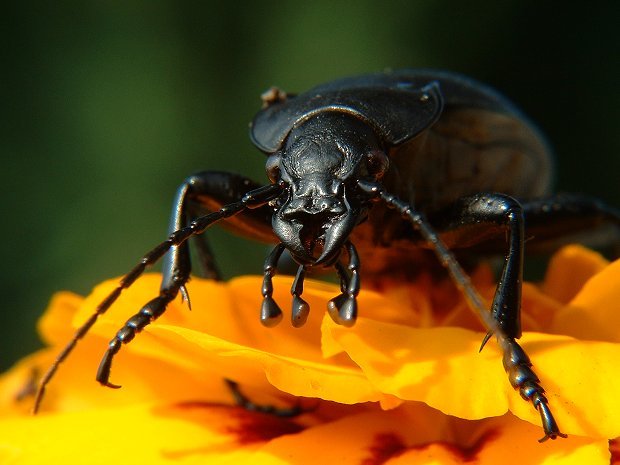
Did you make this great photo? The members of the genus Carabus are looking really impressive.
Yup, animals photography is my passion. If you can visit my profile and look other my photos.
wow mal wieder was gelernt. Danke für diesen tollen Bericht!
Mein Bruder hat die Feuerwanzen als Kind immer gesammelt, als Haustiere quasi - zum Leid der Kindergärtner 😂. Ohje. Hoffentlich liest er das nie nie nie 😅
Toller Artikel! Der Frühling kann kommen🎉👍
Wundervolle Bilder! :)
Es gibt so viele faszinierende Tierchen!
Hm, dein Post bring mich auf die Idee, dass ich mal die kleinen Tiere in Malaysia knipsen sollte. Aber ich kenne mich selbst, wenn ich jetzt auf die Jagt nach den Insekten gehe finde ich nichts :D
Ich finde Insekten seltsam. Habe mal an einer Biene gekaut, da ist mir die Kauleiste angeschwollen. Meine Menschen haben mich zum Tierarzt geschleppt und anstatt Leckerchen gab es dort eine Spritze :) Schmetterlinge sind aber cool :) wuff :P
Sehr schöne Aufnahmen, das ein oder andere Tierchen ist auch schon in unserem Garten vorbei gekommen.
Freut mich, dass dir die Fotos gefallen! :)
It's really good to know about that you really have a vast knowledge of different species of insects which is really an asset which is a plus point of yours you have...If any one is in danger or needs care immediately atleast if you stay present at the spot you can notify doc's that xyz insect had beaten..
I am confused in one thing that all the species came to your garden? Which is good thing some insects you mentioned I am seeing it for the first time..And we rearly see it in India..
Lastly awesome photography skills can't get to know you took it from phone if you did not mention it in the blog...
Insects only populate habitats (for example a garden) if the environmental conditions suits them well enough. For example bees and bumblebees urgently need flowers which offer enough pollen and nectar. So it plays an important role which plants are growing in our gardens. Beetles need opportunities to hide. To fulfill their needs one can arrange a heap of stones together with some deadwood anywhere in the garden.
Ohh thankyou @jaki01 for making the concept so clear and finally got to know the big bang theory of Plants and insects there relation hoping too see a post on this content very soon if possible again...
The collection of the flowers are very beautiful, bright color flowers.
I really like your photos @jaki01
The presence of large bees and other small insects enliven the atmosphere in this beautiful flower garden.
Really natural atmosphere. 🤗😊
Resteem..
Thanks! :)
Your welcome :)
Thank you for the tour of your garden fauna. I live in New York(USA) and thought I recognized some of these critters. Checked out your links on several of them, and sometimes was right. The stinkbug pictured is native to Europe, but has a cousin in New York that has a very similar appearance. Earwigs, it seems, probably are the same critters--originated in Europe but spread to the Americas. In looking them up, I discovered they're lazy--more likely to get around by hitching a ride than flying or walking.
As you can see, your article entertained me. I've been known to read field guides for pleasure. I don't remember much, but do enjoy it. Also, thanks for translating. German is a hobby--it's fun to read the texts side by side.
mantab..photo-potonya keren, pasti camera nya bagus ya Boss..
Beautiful flowers pics , pink flowers are most beautiful .
Awesome photography by you in your garden .
Flowers and birds are looking very cute .
Wow this is very beautiful photography
and great work
Thanks @jaki01
have a great day
very nice moment and angle in A colorful 'small tortoiseshell' . Beauty all in all, thanks for sharing
Wow greet photography my dear friend and 2nd photo is awesome.Thanks for sharing with us.
Have a greet day
is this really the views in your garden mr. @jaki? a beautiful garden with flowers very beautiful friend, thank you for sharing to us all
you have great skills of photography first time see these insects its good for me to read it some thing new for me
Wow..layak untuk diapresiasi karya photography anda @jaki01 sungguh menakjubkan ...saya menyukainya ..lanjutkan....sucses for u....
Nice details on the first picture.
wow😱 just amazing photography.
i love flower
this is a good post and good. this post tells about animal species as well as mamfaat, the dangers of the species and comes with good photographs.
I like this post. and I will always follow it
regards from @sipildanarsitek
The beautiful photography is incredibly beautiful, and I love a beetle perched on that yellow color, sorry I took the picture above in my comment.
Actually it's not a beetle but a bumblebee.
Nice to read that you liked the photos! :)
Large bumblebee suck starch on flowers as their food. Pity the wilted flowers with the habitat of many bumblebees. I noticed that the bumblebee would come back in the morning to look for the flowers that bloom and suck the juice of fresh flowers.
Wow!! Beautiful photography.
I love your post.😍 😍😍
Great job.
Excellent post sir. 🤗💙
Awesome clicks!!
Thanks @jaki01 sir for sharing this post.
Upvoted + resteemed your post.
Thanks for the upvote (and maybe the future resteem). :)
Yes, sir. I always like your post sir. Your all posts have a great content which gives me new idea. 🤗💙
Thank you!
Yes, thanks, too, but other than stated you didn't resteem it (which not a 'duty' anyway) ...